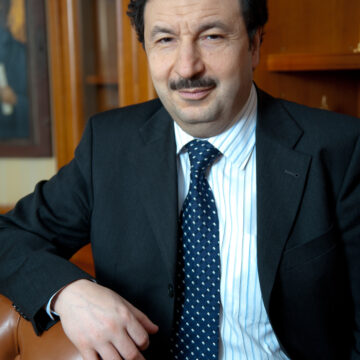The global economic crisis is rapidly growing and it is
difficult to say yet how long it will last. Forecasting the future
of this crisis is as senseless as forecasting crude oil prices.
When they were high, the only thing one could say confidently was
that prices would eventually fall some day. In much the same way,
one can be sure now that the crisis will end one day, although
neither when that will happen, nor the amount of damage, nor the
layout of the post-crisis economy are known yet.
The crisis Russia went through in 1998 had domestic roots – a
weak government incapable of conducting a responsible macroeconomic
(budgetary, in the first place) policy. The current situation is
markedly different: for the first time ever, this country is
coming to grips with a world crisis as part of the global economic
and financial system. This signifies that Russia is gradually
turning into a normal market economy.
One must take account of two important circumstances.
First, the current crisis is bigger than just an
ordinary cyclic one that occurs once every few years. Unfolding
right in front of our eyes are deep-lying tectonic shifts in the
financial –and possibly economic – architecture. Talk about the
need for revamping the global financial model that took shape in
the second half of the 20th century has been in the air for quite
some time, yet this model continued to function and showed fairly
good economic results until recently, although everyone –
politicians and experts alike – could see a growth of systemic
risks. It is obvious now that the post-crisis landscape will change
considerably, as some financial organizations and entire kinds of
institutions will be gone.
Second, in spite of a fair macroeconomic
situation (recall the two-fold budget revenue surplus), the Russian
financial market has found itself in the hardest-hit category
together with the Chinese. This may be a penalty for achievements
as soaring indices attracted too much speculative capital. When the
crisis broke out, this capital started to flow out as quickly as it
had arrived.
The ongoing developments must be a subject of incessant analysis
and discussion, as it is only in this way that an anti-crisis
policy can be formulated. Special attention should be given to an
in-depth analysis of the causes of this crisis, the mechanisms for
interaction between its economic and financial aspects, priority
measures for preventing an economic and financial collapse, the
risks inherent in such measures, and the long-term consequences of
a withdrawal from the crisis. Countries with emerging markets
require special attention too, as their problems are vastly
different from the problems faced by developed economies.
The nature and mechanisms of great economic upheavals are always
enigmatic and hard to fully comprehend. Even many years later,
economic historians are sometimes unable to understand them. The
phenomenon of the Great Depression of the 1930s has still not been
resolved: discussions continue on both its causes and the
effectiveness of Franklin D. Roosevelt’s countermeasures.
This clearly means that the reflections featured in this article
are tentative and its conclusions cannot claim an all-time
validity.
THE ROOT CAUSES OF THE CRISIS
As we analyze the unfolding crisis, it is worthwhile examining
separately three groups of factors that predestined it: first, the
specific problems of the U.S. economy; second, fundamental problems
of today’s economic development; and, third, the specific Russian
circumstances. These factors may produce different results, and
therefore counteraction to the crisis requires taking into account
all the three groups.
It has become customary while discussing the causes of the
crisis to level criticism at the U.S. administration’s
inappropriate budget and monetary policies. In the first place, the
critics point to the pro-cyclic policy pursued after the recession
of 2001, when the country continued accumulating budget deficit
amidst economic growth, instead of reverting to Clinton’s strategy
based on budget surpluses. This was manifest, above of all, in the
policy of keeping low interest rates that remained unrevised for a
long time in spite of the economic growth (see Graph 1). Naturally,
one can hear complaints about the deficiencies of the system of
supervision over financial markets and, consequently, its
regulation, which did not make it possible to take appropriate
measures on time. A proof of this can be found in Alan Greenspan’s
statement at the hearings in the Congress where he spoke about his
superfluous confidence in the market’s ability for
self-regulation.
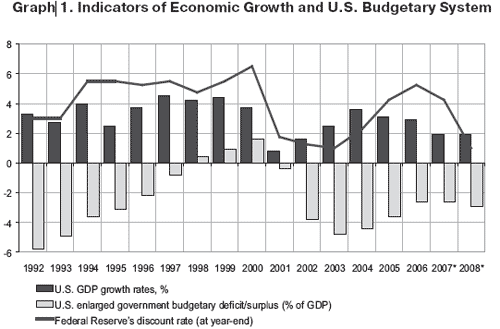
This policy, aimed to artificially whip up growth, has been
quite fashionable in the first decade of the 21st century. As the
leading international players watched China’s double-digit growth,
they did not want to lag behind the future superpower, and that is
why the governments of many countries made steps to stimulate
growth. Remarkably, the hard lessons of an overheated economy
looked outdated – the Great Depression had long become a thing of
the past and it seemed that we had overgrown it intellectually. The
same logic was behind the task of doubling the GDP within a period
of ten years that was set forth by the Russian government. It
mostly concentrated on quantitative achievements and parameters of
volume. However, while the Russian version of the whip-up policy
relied on spare facilities that became available after the crisis
of the 1990s and on a powerful inflow of cash from crude oil, the
American economy had to develop in the conditions of two
simultaneous wars – in Iraq and Afghanistan – which the U.S.
administration could not finance without a budget deficit.
However, there are also deeper-rooted causes of the crisis. They
are linked to the general characteristics of the world economy and
do not boil down to erroneous economic policies.
First of all, one must point out the unprecedented rates of
economic growth that permitted to increase the global GDP by
one-fourth over the past five years. A rapid rise inevitably brings
up systemic contradictions veiled by growing welfare. But the main
thing is that, even if you realize these contradictions, it is
difficult to interfere in the process and adjust anything in it.
Why on earth should any restrictions and corrective measures be
imposed when everything looks perfect? Each time anyone begins to
voice warnings or doubt the correctness of a course amidst an
economic boom, confident voices are heard: “This time it’s
different.”
This applies perfectly well to the U.S. economy’s triple deficit
and current account (see Graph 2). It was clear to absolutely
everyone that a triple deficit did not signal economic health and
could bring detrimental results. But the hope that “this time it’s
different” persisted.
Naturally, these hopes did not grow on a wasteland. They
sprouted out of a rethinking of the new (innovative) approaches
brought up by globalization. We have been speaking much in recent
years about the importance of innovations and transition of the
economy to an innovative pathway of development, and so the crisis
that has burst out can be viewed as a truly innovative one. One can
find at its basis a fast spread of financial innovations – new
instruments of the financial market that, as some people would
think then, would be able to create conditions for an endless
growth and which, as it turns out now, the financial world pundits
had a vague idea of. As a result, the volume of the CDS reached
almost $60 trillion, or four times the size of America’s GDP (see
Graph 3). Thus, the crisis appears to be “a rebellion of financial
innovations against their creators” – a thing that is unpleasant by
not infrequent in history. As one can see now, the situation with
the Barings Bank that went broke in 1995 through the solitary
activity of Nick Leeson, a young trader from its Singapore branch,
was just a harbinger of the crisis, a message to the financial
word, which was never heeded.
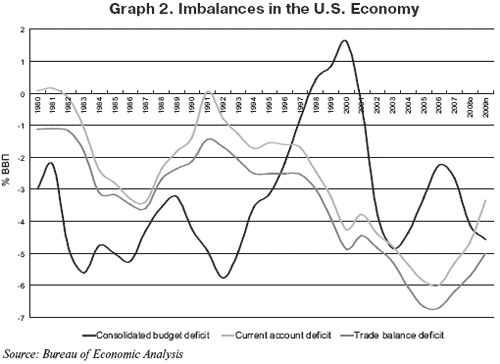
Still, there exists another aspect of globalization that was
also – besides new instruments – seen as a source of endless
financial success and steady growth. Niall Ferguson called this
phenomenon ‘Chimerica,’ meaning a combination of China plus
America. The case in hand is the rise of a global imbalance that
was for decades looked at as a source of well-balanced and
steadfast economic growth. This resulted in a regime that stood in
opposition to the model of globalization that existed at the turn
of the 20th century: whereas a hundred years ago the monies would
flow from the core countries (developed economies) to the periphery
(to the then emerging markets), now the developing market economies
have turned into centers of savings and the U.S. and other
developed countries have mostly become consumers.
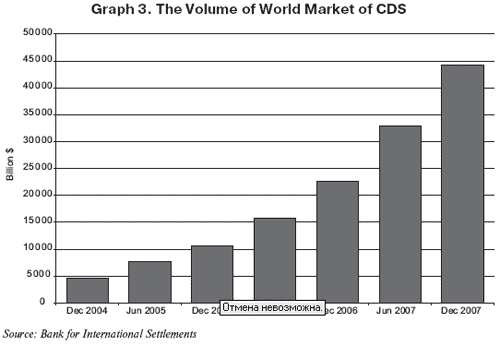
Here is what Ferguson wrote in his book The Ascent of Money:
“Welcome to the wonderful world of ‘Chimerica’ – China plus America
– which accounts for just over a tenth of the world’s land surface,
a quarter of its population, a third of its economic output and
more than half of global economic growth in the past eight years.
For a time it seemed like a marriage made in heaven. The East
Chimericans did the saving. The West Chimericans did the spending.
Chinese imports kept down U.S. inflation. Chinese savings kept down
U.S. interest rates. Chinese labor kept down U.S. wage costs. As a
result, it was remarkably cheap to borrow money and remarkably
profitable to run a corporation. Thanks to Chimerica, global real
interest rates – the cost of borrowing, after inflation – sank by
more than a third below their average over the past fifteen years.
Thanks to Chimerica, U.S. corporate profits in 2006 rose by about
the same proportion above their average share of GDP. But there was
a catch. The more China was willing to lend to the United States,
the more Americans were willing to borrow. Chimerica, in other
words, was the underlying cause of the surge in bank lending, bond
issuance and new derivative contracts that Planet Finance witnessed
after 2000. It was the underlying cause of the hedge fund
population explosion. It was the underlying reason why private
equity partnerships were able to borrow money left, right and
center to finance leveraged buyouts. And Chimerica – or the Asian
‘savings glut,’ as Ben Bernanke called it – was the underlying
reason why the U.S. mortgage market was so awash with cash in 2006
that you could get a 100 per cent mortgage with no income, no job
or assets.”
Finally, the unfolding crisis has one more fundamental
prerequisite, and the most important one. I am referring to the
target-oriented function of the development of business that has
undergone a serious transformation over the past fifteen or so
years. It has turned the growth of capitalization into a
touchstone. This criterion drew the topmost attention of
shareholders and is chosen as a benchmark for assessing the
efficiency of management these days.
In the meantime, the craving for maximum capitalization develops
a sharp contradiction with the fundamental aspect of social and
economic progress – the growth of labor productivity. The increase
of capitalization is linked to the growth of productivity, indeed,
but only in the final count. Meanwhile, executives have to make
reports to shareholders annually. Hence, to get a nice report and
ensure a current growth of capitalization, one needs things that
differ from the factors stimulating labor productivity. Nice
reports require mergers and takeovers, since the volume of assets
helps to build up capitalization. And of course one shouldn’t shut
down outdated production facilities, since their closure slashes
current capitalization. As a result, many large corporations keep
up old inefficient production facilities and technologies.
Apart from the general factors, there are specific reasons for
the fast unfolding of the crisis in Russia. At first glance, the
situation looks paradoxical: the crisis sweeps a country that has
had an especially favorable macroeconomic situation and a double
surplus (of the budget and of the balance of payments). Yet the
reason is explicable: this is the reverse side of the favorable
environment when double surplus attracts capital flows into the
country and actively widens opportunities for borrowings.
Naturally, this process took the opposite direction with the start
of the crisis – an abrupt contraction of opportunities and the
consequent fast shrinkage of the stock market.
Simultaneously, it turned out that the Russian stock market was
still in the phase of budding in spite of a huge growth from 2004
through 2007. Now it may deflate to the minimum parameters, which
however have an internal logic. As shown in Graph 4, the stock
market fall brought the indices to a point where they could have
stayed if the 2005 hike had never occurred. The triangle-shaped
figure shown in Graph 4 graphically reflects the financial market
bubble that resulted from the disproportion-breeding boom.
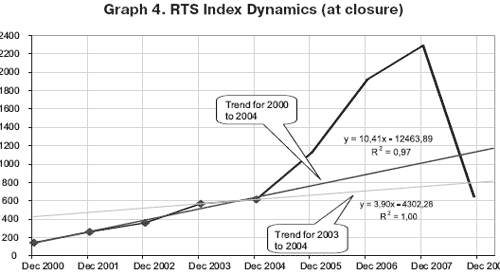
The ineffectiveness of the current structure of the economy and
exports also had a telling effect. In conditions of the domination
of raw materials and investment commodities in exports, the
country’s balance of payments is more heavily dependent on cyclic
fluctuations than in a diversified economy. A slowdown of growth
and flagging activity of investors in importer countries can be a
drag on the economy and trigger a hard landing scenario. This is a
mirror-like effect of the phenomenon that Russia had to tackle
after the crisis of 1998. As the world economy kept growing then,
it generated a demand for Russian products and bred a boom when
energy resource prices began to grow. Much was said about the
importance of structural diversification, but no one would take up
the issue seriously amid the boom (see Graph 5).

A growth of corporate borrowings abroad posed a most serious
problem, especially due to the quasi-state nature of most of them.
Many borrower companies have close connections with the government
and act according to the principle of “privatizing the revenues and
nationalizing the losses.” This is how they are perceived in the
financial market, too, where the agents understand that large
Russian borrowers will always be able to lean against the federal
budget. Thus the situation known as ‘moral hazard’ emerges, as was
the case with the Asian economic crisis in 1997. It means that the
borrowers borrow irresponsibly and the lenders lend rather
groundlessly, while the government has to rescue the debtors in
case of an economic crisis. One can speak here of a tendency
towards cheabolization among the leading Russian companies if a
reference is made to South Korean cheabols that are controlled by
the state de facto and abide by the principle of “privatization of
profits and nationalization of losses.”
An important change of the tendency in the dynamics of foreign
indebtedness took place in 2007 – the aggregate debt burden
(sovereign and corporate) that had been decreasing began to grow.
This heightened the dependence of Russia’s economic position on
fluctuations in the global financial market and pushed up a
full-scale economic crisis (see Graph 6). One more mistake
committed by Russian borrowers was that they easily subscribed to
collateral schemes, although the successes of the Russian economy
made it possible to do without collaterals in the recent years. The
crisis activated the margin calls mechanism that sharply devalued
their collaterals and put up sizable risks for their assets.
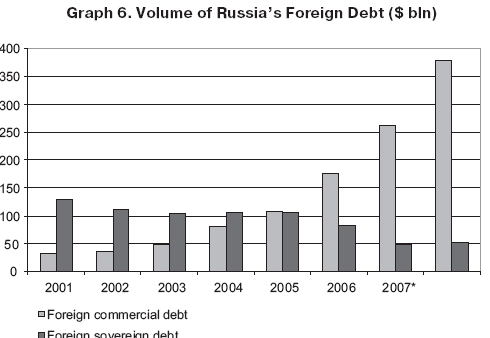
This situation affected the budgetary and exchange rate policy.
On the one hand, the presence of a big number of influential
players – including those having access to the budget – who often
have strategically important assets, limited the opportunities for
lowering the ruble’s exchange rate, which would have sent the cost
of servicing their debts up. On the other hand, a need arose to use
state financial resources to help the borrowers cover or buy out
their debts.
Last but not least, there was a lack of expertise among the
political and business elite that had to – for the first time in
its life – come to grips with a full-scale cyclic crisis (previous
crises were transformational ones). Of course, the elite will get
experience over time, but this will require many more years – and a
variety of economic crises.
FIGHTING THE CRISIS
The crisis came as a shock to the economic and political elite
worldwide. No one expected either such depth or speed.
Economically developed countries, apprehensive of a collapse of the
banking system and a deflation shock, took resolute steps to
support the banks and stimulate production activity. The list of
crucial measures included provision of liquidity, broader
guarantees for bank deposits of private individuals, buyout of
certain banks by the state, aggressive lowering of discount rates,
and adoption of ‘stimulation plans’ (budget injections for
stimulating demand in the real sector). Simultaneously, the
governments of many countries cut down the exchange rates of their
national currencies against the U.S. dollar (see Graph 7). This
measure was meant to help preserve international reserves and to
serve as an additional factor for stimulating domestic production.
An analysis of the logic and efficiency of these measures lies
beyond the format of this article, yet it should be noted that the
key problem is that these measures can provoke a major
macroeconomic destabilization.
From the very start, steps were taken to avert a collapse of the
lending system, and this was a natural consequence of the lessons
learnt from the 1998 crisis. The banks received substantial
financial resources for overcoming the liquidity crisis. On the one
hand, these measures were aimed at supporting production activity,
as the availability of lending resources, not the stock market, is
a source of growth in the real sector in Russia. On the other hand,
stability of the banking system is directly linked to the task of
maintaining social and political stability in the country. The loss
in bank deposits of private individuals will be much more painful
and politically dangerous than any losses in the stock markets.
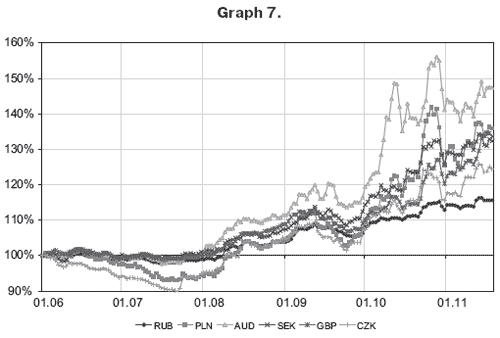
Russian authorities have taken resolute enough measures to
alleviate the impact of this crisis, partly copying the moves taken
in the developed countries and yet acting differently in some
points.
From the very start, steps were taken to avert a collapse of the
lending system, and this was a natural consequence of the lessons
learnt from the 1998 crisis. The banks received substantial
financial resources for overcoming the liquidity crisis. On the one
hand, these measures were aimed at supporting production activity,
as the availability of lending resources, not the stock market, is
a source of growth in the real sector in Russia. On the other hand,
stability of the banking system is directly linked to the task of
maintaining social and political stability in the country. The loss
in bank deposits of private individuals will be much more painful
and politically dangerous than any losses in the stock markets.
Dubious schemes, quite naturally, cropped up, too. The banks
that received liquidity money from the government preferred to
convert as much of it as possible into foreign currency so as to
secure themselves against currency risks or to use it as an
instrument of reducing their debts to foreign lenders. Such conduct
was economically grounded yet ran counter to the intensions of the
monetary authorities which issued the money. Also, there were
situations where the redistribution of the money issued by the
government was effectuated with the aid of bribes, which cannot but
cause astonishment given the fact that a resource in short supply
was distributed at a discounted price. (Unlike primary borrowers,
second-tier borrowers were supposed to get the money at a price
that would be slightly bigger than the interest at which the
primary money was distributed.)
The government tried to prop up stock market indicators to a
certain degree, but it had to give up the idea very soon. Although
the dynamics of the stock market indicators is always impressive
and stirs dramatic passions, it is not the sphere where the state
should concentrate its resources. Supporting the stock market in
this situation meant only one thing – helping fleeing investors
withdraw money from this country by selling securities. True,
devaluation of shares is unpleasant for shareholders and creates
problems with margin calls, but the solution of this problem lies
in a different plane.
The latter problem was especially painful, as the debts of
Russian companies to foreign loaners posed a real threat of an
outflow of Russian assets – into the hands of those who were
crisis-stricken themselves.
The fast economic growth in the past few years was largely due
to the availability of inexpensive money resources in the world
market. Russian companies borrowed them eagerly. But the
inexpensiveness of money does not make investing more efficient,
especially when one looks at companies linked to the state. The
understanding that the state will not let these companies die at a
critical moment lubricates the issuance of loans to them.
The situation has changed, however. There are no easily
accessible loans any more, while the securities collateralized
against loans are devaluating. (This was another mistake made by
Russian borrowers who easily agreed to collateral schemes, although
the Russian economy’s performance over the recent years made it
possible to do without collaterals in many cases.) A total of $43
billion was to be paid off on these debts before the end of the
year, and the state said it was ready to make available the funds
of around $50 billion through Vneshekonombank (VEB) to get out of
the situation. Still, a question is looming: Was the mechanism of
utilization of the funds correct? Allocation of money to debtors
for repayment of their debts is far from the most efficacious way
of resolving the problem. It would have been much better if the VEB
had bought up these debts. Steps of this kind would help these
companies, above all, to increase their capitalization in the
future and reduce the spreads on these debts.
The exchange-rate policy was dubious, too. The authorities did
not venture – obviously for political reasons – to fully give up
support for the ruble’s exchange rate, which resulted in a sharp
slimming of foreign exchange/gold reserves. The reasons for the
cautiousness are quite clear: devaluation of the national currency
– a third over the past twenty years – would not facilitate the
growth of trust in the government. But the opposite situation, i.e.
the exhaustion of resources, looks no less risky. I believe that
prevention of considerable devaluation of reserves has a much
greater importance for ensuring stability of the Russian economy
than the steadiness of the national currency. More than that,
gradual lowering of the ruble’s rate would serve as a
lifeline for domestic producers, defend the Russian market
against imports, and create additional incentives for an inflow of
foreign direct investment in the future.
And yet a policy like this naturally invites resistance of those
who have sizable debts denominated in foreign currencies. A
weakening of the ruble is synonymous with a hike of the price of
their debts. These powerful forces have enough clout for lobbying
their interests. The issuance of money for buying out their debts
should have made them mitigate their stance. In a word, apart from
being an important economic indicator, the dynamics of the exchange
rate will also be a political indicator in the next few months, as
it will create a real balance of forces between the main economic
players.
Finally, the government offered a package of incentives, above
all taxation ones, for supporting the development of the real
sector. There are serious doubts as to the efficiency of this
package, as the shortage of money is not the main problem in the
manufacturing sector. The core problem is the faulty functioning of
economic mechanisms and, as a result, the inefficiency of many
producing industries. Although bountiful money injections can make
the current social problems less intense, they will not resolve the
problem of making production more efficient and renovating the
structure of the economy. And without this the crisis will only get
more dragged-out.
SLOGANS OF THE DAY: SOCIALISM AND POPULISM
An analysis of the current crisis in the context of long-term
historical trends and in retrospect of the past 150 years vividly
shows swelling manifestations of two critical trends in
20th-century economic history, namely, socialism and populism.
Political demand for these trends is always heightened during
economic crises and social cataclysms, and today’s situation is no
exception.
Both models were tested in the past century and both failed to
live up to the great expectations that had been pinned on them.
Socialism was mostly an experiment in Europe and Asia, while
populism was tried in Latin America. The results are well known –
both experiments flopped. Socialism solved the task of
industrialization with enormous sacrifices, but it did not find
internal resources for further development. Populism showed an
enviable consistency in driving flourishing countries, beginning
with Argentina under Juan Peron, into economic and social
disaster.
“In the UK everyone is a social democrat now,” read a headline
in The Financial Times (October 7, 2008. p. 11). It shows
graphically that the public at large buys into socialist ideas like
hot cakes when the financial system is about to collapse and people
are apprehensive about diminished incomes. A fiasco of
market-oriented ideology and market values in the mentality of a
big part of the elite and society is as clear as daylight. Apart
from rare exceptions, both the rank-and-file and government appear
to be ready to “buy” socialism immediately to maintain their
quality of life, however imaginary. Everyone agreed that the
proposed measures were “essential and the only possible ones.”
It was the authorities, and not the market at all, that began to
make decisions on who should be guillotined or pardoned. The
situation surrounding Lehman Brothers, on the one hand, and with
Bear Stearns and AIG, on the other, does not stand interpretation
in market terms. The government simply decided to sort out
relations with one corporation and to help the other, the way it
happens in a centrally planned economy. And of course all of this
was wrapped up in the appropriate rhetoric.
A much greater problem is posed by the policy of socialization
(or nationalization) of risks. As the government saves debtors,
replenishes banks with money (recapitalizes them) and sharply
increases guarantees on private deposits, it assumes the risks
inherent in the decisions of all major economic actors – bankers,
investors and borrowers (all the more so that they are often the
same people). This undermines the fundamental principle of
capitalism – personal responsibility for decision-making. If one
takes Russia, one can be sure that nationalization of the losses
unavoidably leads to nationalization of the risks. This process
begins in the banking sector and spreads to other corporations and
sectors through bank guarantees.
Ownership relations, the inner sanctum of any social and
economic system, undergo a deep transformation. Providing financial
aid to distressed corporations opens the way towards their de facto
nationalization. This is done through at least three channels – the
buyout of debts from certain corporations, recapitalization in
exchange for shares, and inflation of accrued liabilities.
Governments are inclined to take on all the liabilities of
financial institutions – through guarantees and through direct
injections of money as well. Naturally, aid to financial
institutions goes hand in hand with formal or factual washing out
of packages belonging to private owners. The rights to private
ownership – above all, of financial institutions (in the West) and
corporations in the real sector – are being called into question.
The latter process is quite visible in Russia, especially with
regard to those whom the state rescues from margin calls.
Government decisions regarding the nature of activity of the de
facto nationalized institutions will be the next, and quite
logical, step. Harold Brown said he would continue to stimulate the
banks that had come under his control in order to invest more money
in small businesses. Support for small business is a sacred cause,
no doubt about it, and all contemporary governments love doing
this, but the aftermath of these kinds of decisions is easy to
predict. When the authorities order where to invest, they will have
to render assistance to the loyal banks whenever this politically
motivated investment proves inefficacious. That is, state support
and ineffective investment form an endless circle. The Europeans
were the first to declare this set of measures in a statement on
October 12, 2008 and the Americans joined them two days later.
Finally, it is worth remembering that huge capital inflow is due
to stream into the market shortly and this will whip up inflation
with a simultaneous drop in production. Russians are accustomed to
living with high inflation, and, as we could learn from the
experience of the 1990s, it is not only a matter of monetary
policy. It also has a redistributive effect. Edmund Burke was the
first to point to this, discerning the paper money of the French
Revolution in 1790 as an ominous token of private property
expropriation.
The risks of populist policies are looming large simultaneously
with socialistic tendencies. The crisis is already spreading to the
manufacturing sector. As growth rates slow down, problems with
unemployment may surface. The most dangerous thing in this
situation would be to try to stimulate growth with the help of
budgetary injections. This will only add to the burden: countries
overwhelmed by crisis will have to spend vast amounts of money to
support liquidity in the economy and bring stability to the lending
system.
Calls are being heard in the West and in Russia to assist
manufacturers. Yet doling out cheap money to them would have
dangerous consequences in this situation, even though it may bring
about a short-lived increase in growth. It would not produce a
steady result, while more rampant inflation would put up obstacles
to investment. Meanwhile, one should remember that Russia is past
the phase of recuperation growth, which requires demand and
political stability to a greater degree than investment. The latter
is turning into a source of economic growth now, and populist
policies can undermine the conditions necessary for it. It would be
unforgivable to fight the financial crisis with one hand and build
barriers to economic growth with the other hand.
A turn towards socialism obviously reveals an attempt to gain
more time for a respite and a reconsideration of values. It is too
early to say yet how long it will last, but it will certainly not
last forever. Any excessive state regulation goes against modern
flexible production forces and the challenges of the
post-industrial era. That is why one can hardly claim that the
current etatist regulatory systems have arrived “to stand and
deliver.” Populism is a different story. Populism is ineradicable
and its proliferation merely reflects the quality of the national
elite.
RISKS OF ANTI-CRISIS STRUGGLES
A discussion of the problems of the current crisis revolves in
one way or another around historical precedents and the genetic
apprehensions born out of them. This refers first of all to the
Great Depression, which was marked by protracted deflation and
double-digit unemployment figures. It was only fully overcome
thanks to World War II. References are also made to the crisis of
the 1970s that gave birth to a new phenomenon – stagflation.
Measures taken by governments in developed countries
today suggest that they mostly fear deflation, which may take a
decade or more to cope with. In addition to the crises of the
1930s, the Japanese economic crisis in the 1990s furnishes an
example, as well.
a crisis may proceed and that is why they suggest radically
different approaches. Fighting deflation requires stimulating
demand, i.e. an active budget policy and budgetary expansionism.
This helps to lower taxes and discount rates, together with huge
budgetary spending. Dealing with stagflation requires a set of
opposite measures, above all control over the money supply – that
is, consolidating budget policy and increasing interest rates.
Following the decade-long economic crisis of the 1970s, a way out
of the situation was found only after the head of the U.S. Federal
Reserve System, Paul Walker, dared to take unprecedented austere
measures that drastically increased the discount rate. As a result,
U.S. unemployment surged to over 10 percent and interest rates
soared to over 20 percent. The country plunged into a deep
recession, for which Jimmy Carter paid a dear price – he lost the
presidency, but the country re-emerged with a revamped and dynamic
economy.
the ongoing crisis will hardly replicate either form, but what
matters for us is the understanding that the therapy depends on the
nature of the illness and may require very different or even
radically opposite remedies. The experience of both crises may
prove handy in the current situation. Strictly speaking, developed
countries now resort to policies that they found inadmissible for
emerging markets (including post-Communist countries) in the 1980s
and 1990s.
Union can now actually prevent the deterioration of the economy
from going beyond the politically tolerable level, but one must use
caution in applying these measures in developing economies. The
problem is the U.S. fiscal authorities have two distinctive
features. First, they control the printing press that churns out
the world’s reserve currency. And, although its status has been
shaken somewhat, no one seriously calls this into question.
in U.S. currency and are interested in maintaining its relative
stability. Second, due to this very special status of the U.S.
dollar, corporations and households do not have alternative
instruments for hedging monetary risks – it is most unlikely that
they will rush to exchange their dollars for euros or yens even if
they start doubting the correctness of the steps taken by the
fiscal authorities. This explains why the speed of monetary
movement in the U.S. is not increasing in contrast to other
countries, despite the budgetary and financial expansionism in the
past few months. The reaction to financial expansion in the
majority of emerging economies, including Russia, will be
completely different. Weaker budgetary and monetary policies in
countries where the national currency has not formed a durable
credit history and, naturally, is in no way a reserve currency will
most probably result in a flight from the national currency, as
well as in an increase in the speed of money movement and
inflation. In a global recession such developments will unavoidably
mean stagflation.
countries where raw materials dominate exports. Those economies are
extremely dependent on international markets since even a small
weakening of demand there evokes a considerable slump in production
in their export industries.
and demand for commodities from developing economies decreases,
depression in the latter countries may go hand-in-hand with a
flight from the national currency. Budgetary interventions cannot
compensate for falling external demand, and this situation breeds
inflation that is not accompanied by growth in production
activity.
where deflation in one part of the world will combine with
stagflation in another part, and the biggest risk for today’s
Russia comes exactly from stagflation.
crisis and the ways out of it. The world may actually face two
simultaneously developing forms of the crisis, which, consequently,
require completely different approaches. Fighting deflation in the
West will push inflation beyond its borders, i.e. to developing
economies, while the latter will quickly fall into the trap of
stagflation as they copy Western anti-crisis measures.
non-diversified exports pegged to mineral resources. If business
activity and demand for exported goods remain low in importer
countries, depression will go hand-in-hand with a flight from the
national currency and this will be manifested, among other things,
in inflation. The de facto nationalization of many financial
institutions and enterprises has big risks of its own too. Russia
is actually reproducing the situation that emerged at the turn of
the 1980s when the so-called “red directors” played an especially
active role. This category of managers received broad powers
to manage enterprises in the absence of owners to whom they would
have had to report. The state could no longer exercise control over
economic agents then, while private owners had not emerged yet. In
other words, the “red directors” had de facto ownership rights
without having owner motivations. History shows that businesses and
the entire national economy had to pay a dire price for that.
state buys out debts, it actually establishes control over a
sizable number of companies, which thus get management connected to
the state. But due to the understandably different access to
information, this manager will have obvious advantages over the
officials, albeit very high-ranking ones, who put him in the post.
This, in turn, pushes the moral hazard problem higher up the
spiral, as the manager’s personal interests start dominating over
the interests of the company.
re-privatize de facto nationalized companies. This kind of plan
must be broadly known to the political and business elite and,
above all, to the owners if they stay interested in the
business.
crisis as a pretext for reassessing the correlation between the
roles of the state and private enterprise. The crisis is often
explained by the insufficient interference of the state and by its
inability to exercise effective regulation when innovative
financial instruments and technologies appear. Most people put all
the blame on the free market and few dare defend the values of free
entrepreneurship. Only a handful of individuals risk saying that
“it wasn’t deregulation that allowed this crisis. It was the
mish-mash of regulations and regulators, each with too narrow a
view of increasingly integrated national and global markets.”
technologies and quick renovation of all technological and economic
aspects of life – will not disappear. This world resists
centralized regulation and bureaucratic interference in the subtle
tissues of its interests. Even if one acknowledges the importance
of targeted state regulation of financial markets, it would be a
great mistake to extrapolate the regulatory conclusions (and
consequently the regulatory practices) to the manufacturing
sector.
the Western economic model and liberal capitalism today and this
talk may make some sense from the political point of view. Yet it
would be silly to fall victim to one’s own propaganda. All of
economic history shows that however harsh a crisis may be and
whatever stage of capitalism’s decomposition is attributed to it,
market economies have always survived crises, and emerged from them
stronger, tougher and more competitive. The crisis will end sooner
or later, and then we will have to compete with economies that are
not only stronger, but also hungrier and, as a consequence, more
aggressive.
already start getting ready for it now. Not only does the crisis
leave the need for economic, political, social, and military
modernization unabated, it resolutely demands a course of
modernization that should be laid out in the government’s program
documents, so that we can face our competitors with something
bigger than state banks and state corporations when the crisis is
over.
the price you will have to pay for surviving it, but it has an
encouraging factor, as well – it may mark the beginning of
rejuvenation, of a healthier growth, and of a cleansing from the
sludge of pre-crisis agitation. The degree to which it proves to be
beneficial depends on the efficiency and resoluteness of the
government’s actions and on the responsibility and unity of the
national elite.
the part of the government and business community to measures for
building mutual trust among market players. To this end they must
make their actions clearly understandable to each other. It is
important to provide information to the public about which
financial institutions receive federal money, how much they receive
and, moreover, how this money is being used. The crisis has shown
once again that a market economy is built primarily on trust – a
trust that is grounded in transparent information, not in the
ability of one side to subjugate the other.





